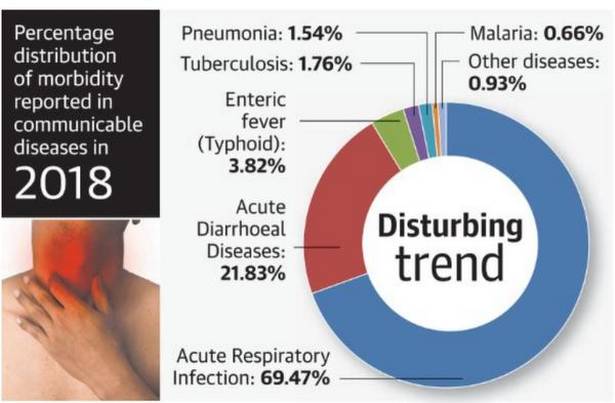National Health Profile report 2019 released – Diligent IAS 06/11/2019 – Posted in: Daily News – Tags: Acute respiratory infections, Central Bureau of Health Intelligence, National Health Profile, World Health Organisation
NATIONAL HEALTH PROFILE REPORT
For: Preliminary & Mains
Topics covered:
- Key findings of the National Health Profile report
- What do you mean by National Health Profile?
- What are Acute respiratory infections?
- About Central Bureau of Health Intelligence
News Flash
National Health Profile 2019 was recently released by the Union Health Ministry.
Report’s findings
- Acute Respiratory Infections (ARI) accounted for 69.47% of morbidity last year which was the highest in the communicable disease category leading to 27.21% mortality.
- Andhra Pradesh, Gujarat, Karnataka, Kerala, Tamil Nadu, Uttar Pradesh and West Bengal reported a large number of patients and fatalities due to ARI.
- Life expectancy in India has increased from 49.7 years in 1970-75 to 68.7 years in 2012-16. For the same period, life expectancy for females is 70.2 years and 67.4 years for males.
- The survey notes that 6.51 crore patients attended the non-communicable diseases (NCD) clinics.
- According to the survey, the highest population density of 11,320 people per square kilometre was reported by the NCT of Delhi whereas Arunachal Pradesh has reported the lowest population density of 17.
- There has been a consistent decrease in the birth rate, death rate and natural growth rate in India from 1991 to 2017.
- As of 2017, India has registered a birth rate of 20.2 per 1,000 population and death rate of 6.3 per 1,000 population while the natural growth rate was 13.9 per 1,000 population in India.
- The birth rate in rural areas was higher than in urban.
- The death rate and natural growth rate were also higher in rural areas as compared to the urban.
- The population, however, continues to grow, as the decline in the birth rate is not as rapid as the decline in the death rate.
- The infant mortality rate has declined considerably (33 per 1,000 live births in 2016), however, differentials of rural (37) & urban (23) are still high.
- The Total Fertility Rate (TFR) for the country was 2.3 whereas in rural areas it has been 2.5 and it has been 1.8 in urban areas during 2016 as per the latest available information.
- The survey finds that on communicable diseases, in 2018, the maximum number of cases and deaths due to malaria have been reported in Chhattisgarh (77,140 cases and 26 deaths).
- Dengue and Chikungunya, transmitted by Aedes mosquitoes, are a cause of great concern to public health in India.
- Every year, thousands of individuals are affected and contribute to the burden of health care.
- The reported cases of Chikungunya in the country has shown a slight decrease.
- There has been a considerable decrease in the number of swine flu cases/deaths.
- Suicide rates are increasing significantly among young adults and the maximum number of suicide cases (44,593) is reported between the age group 30-45 years.
- During the year 2015, 4.13 lakh people lost their life due to accidental injuries and 1.33 lakh people died because of suicide.
- The total number of cases and deaths due to snakebite are 1.64 lakh and 885, respectively, in 2018
- The total number of disabled persons in India is 2.68 crore.

National Health Profile report 2019 released
Acute respiratory infections
According to the World Health Organisation, Acute respiratory infections (ARI) is a serious ailment that prevents normal breathing function and kills an estimated 2.6 million children annually every year worldwide.
National Health Profile
National Health Data is essential for effective planning, decision-making, monitoring and evaluation of various Health Programmes & Health Sector Development activities.
To achieve this objective, the Central Bureau of Health Intelligence (CBHI), annually brings out a Publication “National Health Profile (NHP), which covers all the major information on Demography, Socio-Economic Status, Disease Morbidity & Mortality, Healthcare Finance, Human Resources in Health and Healthcare Infrastructure.
Central Bureau of Health Intelligence
- CBHI was established in 1961 by the Act of Parliament on the recommendation of the Mudaliar committee. It is a health Intelligence Wing under Directorate General of Health Services (Dte.GHS), Ministry of Health & Family Welfare (MoHFW).
- CBHI was established with the vision to have “a strong Health Management Information System (HMIS) in the entire country”.
- Its mission is to strengthen the Health Information System (HIS) in each of the districts in the country up to the facility level for evidence-based decision making in the Health Sector.
Source: The Hindu, Business Standard
READ MORE DAILY NEWS
- No signing of the RCEP
- 14th East Asia Summit
- Assam Project for Forest and Biodiversity Conservation (APFBC)
- Meghalaya Residents Safety and Security Act 2016
- Nanak Naam Lewa Sangat (Nanakpanthi)
- National Research Institute of Unani Medicine for Skin Disorders (NRIUMSD)
You are on the Best Online IAS preparation platform. You are learning under experts.
We are present on Facebook- Diligent IAS, LinkedIn- Diligent IAS, YouTube- Diligent IAS, Instagram- Diligent IAS. Get in touch with us.
